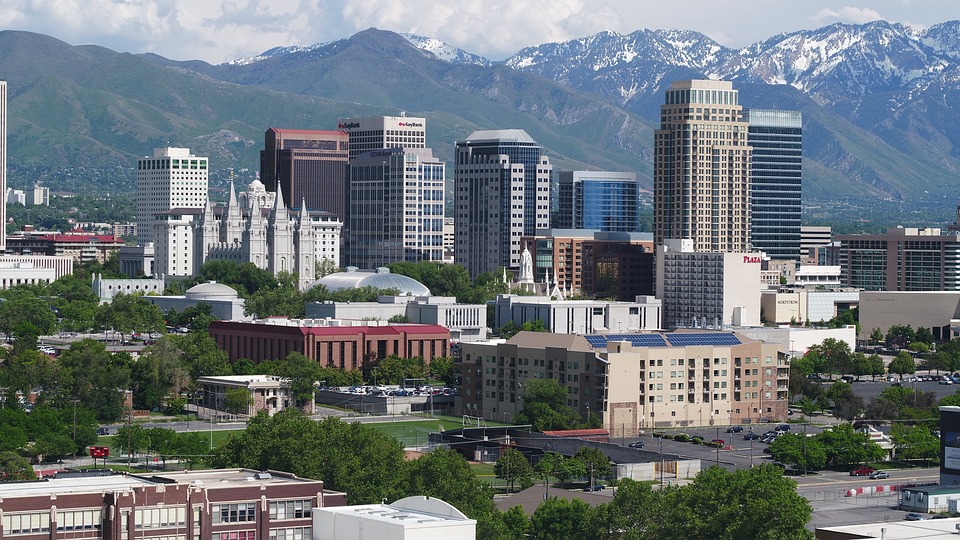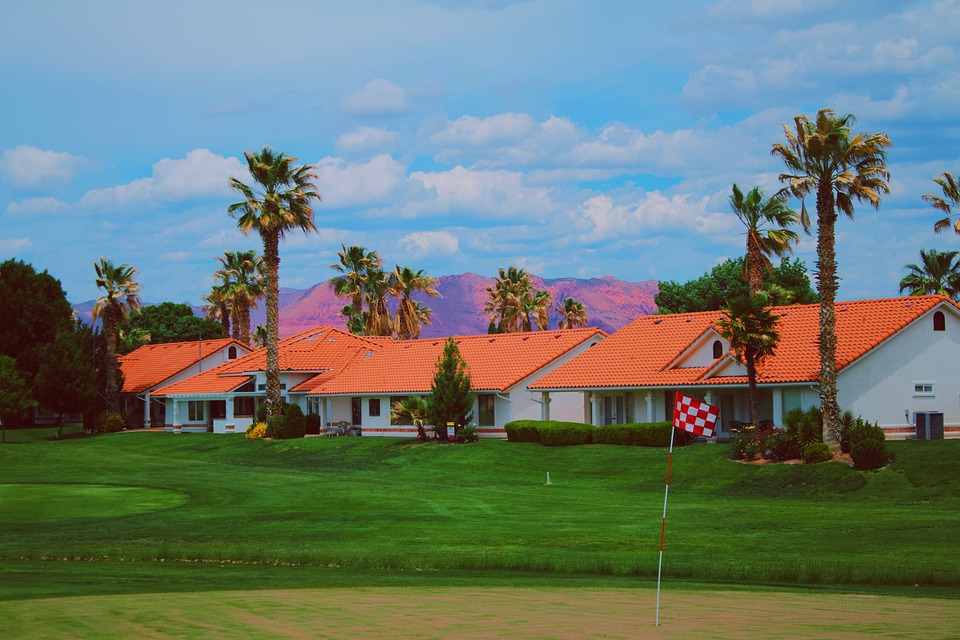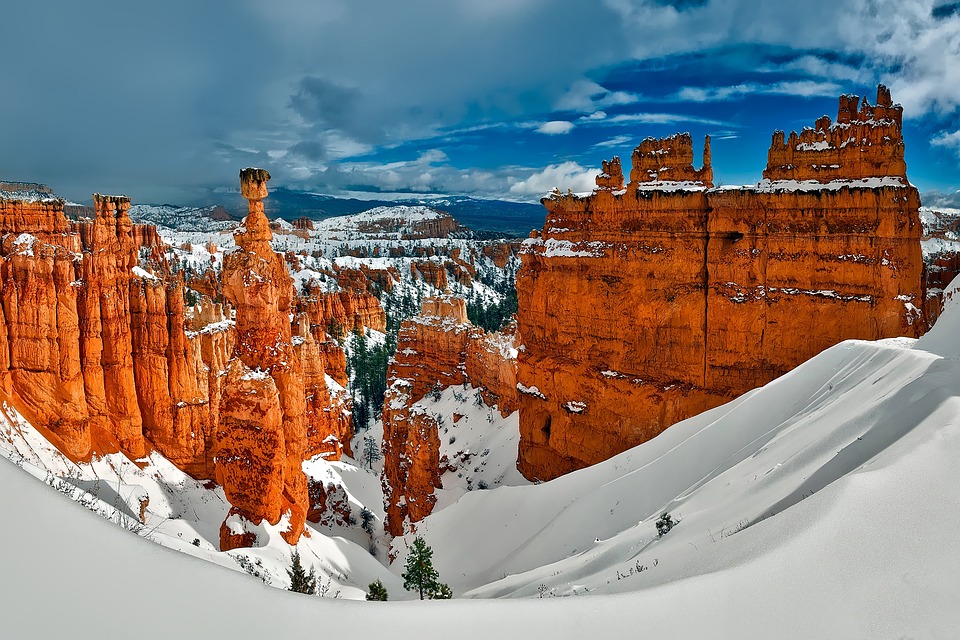Utah State

Location
Utah is a state located in the western United States. It borders six other states: Arizona to the south, Nevada to the west, Idaho and Wyoming to the north, Colorado to the east, and shares a “four corners” point with Arizona, Colorado, and New Mexico. The state capital is Salt Lake City, one of the region’s key cities. Utah covers an area of approximately 220,000 square kilometers, making it the 13th largest state in the U.S. The state boasts diverse landscapes, ranging from deserts to mountain peaks.
Climate and Landscape
The climate of Utah varies depending on the region due to the state’s large size and diverse terrain. Southern Utah experiences a desert and semi-desert climate, with extremely hot summers and mild winters. In contrast, the northern part of the state, particularly around the Wasatch Mountain Range, has a continental climate with cold winters and moderately warm summers.
Summer temperatures can reach 35-40°C, especially in desert areas, while in mountainous regions like Bryce Canyon, temperatures are much cooler. Winters in the mountains are harsh, with heavy snowfall, making Utah a popular destination for winter sports enthusiasts. Snowfall is common in the Salt Lake City area during the winter months, while desert regions receive very little precipitation.
Utah’s landscape is also incredibly diverse. The state is known for its national parks, such as Zion, Arches, and Canyonlands. It features deserts, canyons, mountains, salt lakes (notably the Great Salt Lake), and plateaus, making it a prime destination for tourists and nature lovers.

Population
Utah’s population is growing rapidly due to both natural growth and migration. According to recent census data, the state’s population is around 3.4 million people. Utah has one of the youngest demographics in the U.S., with a median age of approximately 31 years, significantly younger than the national average. This is attributed to high birth rates and a large number of young families.
The ethnic composition of the population is fairly homogenous, with the majority (about 78%) being White Americans. There are also small communities of Latinos (around 14%), African Americans, Asians, and other ethnic groups. An important part of Utah’s social fabric is the Church of Jesus Christ of Latter-day Saints (Mormons), whose members make up about 62% of the state’s population. This significantly influences the culture, lifestyle, and even political decisions in the region.
Salt Lake City, the capital, is the most populous city in the state, with a population of around 200,000 people, though the metropolitan area includes over 1 million residents.
Crime
Utah is considered one of the safer states in the U.S., with a crime rate below the national average. According to FBI data for 2022, the rate of violent crime in the state was about 226 incidents per 100,000 people, significantly lower than the U.S. average of approximately 380. However, as in any state, crime levels can vary depending on the city and region.
Salt Lake City has a higher crime rate compared to other cities in the state, particularly in property crimes such as theft and burglaries. However, the city regularly undertakes initiatives to reduce crime, and improvements have been noted in recent years.
Overall, most towns in Utah are considered quite safe, especially smaller cities and rural areas. Statistically, Utah ranks low among states with high crime rates, making it appealing for families and those looking for a more peaceful environment.

Economy
The state is known for its low unemployment rate, which stood at about 2.4% in 2023, one of the lowest in the country. Key sectors of the economy include technology, tourism, finance, manufacturing, and energy. Salt Lake City has become a hub for the tech industry, earning the nickname “Silicon Slopes” due to the significant concentration of tech companies, particularly startups.
The minimum wage in the state is $7.25 per hour, which matches the federal minimum rate. However, actual incomes are relatively high, with the median household income around $88,000 per year, placing Utah in the top 15 states for income levels.
Poverty is relatively low in the state, with about 9% of the population living below the poverty line, which is also lower than the national average.
In addition to technology, Utah is a key center for agriculture (growing wheat, corn, and sugar beets), mining (oil, natural gas), and manufacturing. Tourism also plays a significant role in the state’s economy, thanks to its numerous national parks and ski resorts.
Utah for Business
Utah is an attractive state for business, especially for startups and tech companies. The state actively supports entrepreneurial activity with its favorable tax climate and simple business registration process. Utah ranks highly in national rankings for business-friendliness, consistently being one of the top states for low taxes and regulations.
The state’s tax system includes a flat 4.85% income tax rate for individuals and businesses, making it competitive compared to other states. Additionally, Utah has no social security taxes, and the sales tax is lower than in many other regions of the U.S.
Utah offers a well-developed infrastructure, including access to major transport routes and airports, such as Salt Lake City International Airport. The presence of major companies like Adobe, eBay, Qualtrics, and Overstock fosters local job growth and creates opportunities for skilled professionals.
Strengths for doing business in Utah include:
- Low taxes and ease of company registration.
- Access to a skilled workforce, particularly through local universities and training centers.
- A favorable business climate for startups and tech companies.
However, the drawbacks may include relatively high competition in the tech sector and reliance on natural resources in some industries, such as oil and gas extraction.
Real Estate
Utah’s real estate market is growing rapidly, especially in recent years due to the state’s fast population and economic growth. Housing prices in Utah remain relatively affordable compared to states like California or New York, though prices in Salt Lake City and its suburbs have risen significantly due to high demand.
As of 2023, the median home price in Salt Lake City is approximately $560,000, while the average rent for a one-bedroom apartment is around $1,400 per month.
In smaller towns, such as Provo or Ogden, housing prices are much lower — the median home price can be about $400,000, and rent is around $1,000 per month.
The rise in real estate prices is driven by the influx of new residents, the growth of the tech industry, and limited housing supply in popular areas. However, many developers are working on expanding affordable housing, especially in the suburbs.

Ecology
Ecology in Utah is an important issue, as the state has both strengths and challenges in this area. Utah’s natural landscapes, such as deserts, canyons, and mountain regions, are protected through national parks and nature reserves. However, some areas face issues related to air and water quality, particularly during winter months when Salt Lake City suffers from “inversion” — a phenomenon where cold air traps pollution near the ground, leading to poor air quality.
On the positive side, the state places significant emphasis on conserving natural resources and promoting environmental sustainability. Utah is investing in the development of renewable energy sources, particularly solar and wind power. Additionally, in the mountainous areas, programs are in place to conserve water resources, which are critical for maintaining ecosystems in the arid climate.
The Great Salt Lake, a unique natural landmark in Utah, is at risk of depletion due to climate change and a declining water level, which could also affect local wildlife and plant life.
Landmarks
Utah is known for its unique natural and historical landmarks, attracting tourists from all over the world. One of the state’s main tourist attractions is its national parks, each offering breathtaking landscapes.
- Zion National Park — located in the southwestern part of the state, this park is famous for its majestic canyons, rock formations, and hiking trails that allow visitors to enjoy stunning views.
- Arches National Park — one of Utah’s most famous parks, known for its natural stone arches that have formed over millions of years due to erosion.
- Bryce Canyon National Park — a park known for its red rock amphitheaters that create stunning panoramas. This site is especially popular for stargazing due to its lack of light pollution.
- Great Salt Lake — a unique natural landmark and the largest saltwater lake in the Western Hemisphere. It attracts not only for its vastness but also for the large number of birds nesting on its shores.
- Canyonlands National Park — a vast park with canyons and plateaus carved by the Colorado and Green rivers. The park offers excellent opportunities for hiking, camping, and rafting.
In addition to natural wonders, Utah also features historical and cultural landmarks, such as the Mormon Temple in Salt Lake City — one of the most recognizable religious structures in the U.S.

Possible Disadvantages of Living in Utah
Despite the many advantages of living in Utah, there are certain disadvantages that can be challenging for new residents.
- Climate conditions. While many people appreciate the four seasons, Utah is known for its harsh winters, especially in mountainous areas. Winters can be long and cold, with significant snowfall, making travel difficult, especially for those unaccustomed to such conditions. Salt Lake City also experiences air inversion during winter, leading to poorer air quality.
- High housing costs in some areas. Although real estate in many parts of Utah remains affordable, housing prices in Salt Lake City and its suburbs have risen significantly in recent years. This can be a challenge for newcomers, especially those looking for affordable housing in the capital or surrounding areas.
- Limited cultural diversity. The high concentration of members of the Church of Jesus Christ of Latter-day Saints (Mormons) can create a sense of cultural homogeneity in some regions, which may not be ideal for those accustomed to more multicultural environments.
- Alcohol access and leisure restrictions. Utah’s alcohol laws are among the strictest in the U.S., which can be inconvenient for those used to more relaxed regulations. Additionally, some establishments close earlier than in many other states.
Why People Move to Utah
People move to Utah for several reasons. One of the main reasons is the state’s stable economy, offering numerous job opportunities, especially in the tech industry, construction, and healthcare. Utah is also known for its relatively low unemployment rate and high per capita income, making it attractive to young professionals and families.
Another key reason for moving is Utah’s quality of life. The state offers exceptional conditions for outdoor recreation, from skiing resorts in winter to hiking trails and national parks in summer. The culture of healthy living and access to natural beauty makes Utah a popular place for those who value a balance between work and leisure.
Additionally, Utah boasts high-quality education. The state is home to several renowned universities, including the University of Utah and Brigham Young University, providing strong academic preparation. This attracts students and young families looking for good educational opportunities for their children.
Table of Contents